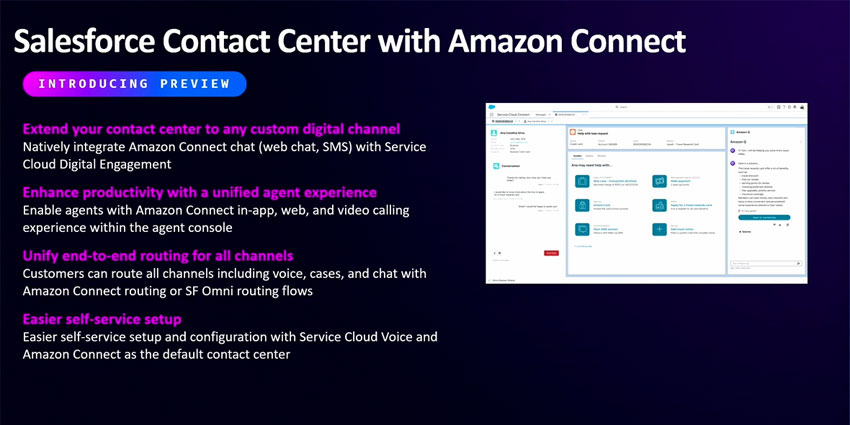Last month, AWS announced a preview of the Salesforce Contact Center with Amazon Connect.
The solution natively integrates with Service Cloud Voice and is available on the Salesforce AppExchange.
Essentially, it allows Service Cloud users to leverage additional capabilities from Amazon Connect – like digital channels, in-app voice, and unified routing – as part of a coordinated CRM environment.
Celebrating the launch, Marc Rudkowski, Principal Product Manager at AWS, declared at re:invent:
The future is here with the Salesforce Contact Center with Amazon Connect.
In doing so, he recognized the need for tighter CCaaS and CRM integrations that unify customer service data and help pump it into the broader customer experience ecosystem.
As a result, brands may unify customer profiles and better power AI models across that ecosystem.
That’s especially helpful with more GenAI capabilities coming to the fore across service, sales, and marketing. But, it’s also significant for all those emerging hyper-personalization uses.
While CX Today caught wind of the Salesforce Contact Center with Amazon Connect in November, Rudkowski shared more details during his presentation at AWS’s annual conference.
In doing so, he highlighted four critical capabilities of the Salesforce Contact Center with Amazon Connect. They are:
- Custom Digital Channels – The offering enables “Bring Your Own” (BYO) options for Amazon Connect Chat and SMS, which integrate natively into the Salesforce Unified Agent Experience. As such, agents and customers can shift across blended channels seamlessly.
- End-to-End Routing Across All Channels – Customers can choose to pass voice interactions, cases, and chats to agents, either through Salesforce Omni routing flows or Connect routing.
- A Unified Agent Experience – While Service Cloud Voice supports telephony, the new solution unlocks web calling in Service Cloud. Rudkowski also indicates that video calling and screen sharing will come soon.
- Self-Service Set Up – The Salesforce Contact Center with Amazon Connect offers a natural extension of the Service Cloud Voice setup process. So, once the business has configured Service Cloud Voice, installing and enabling the new offering should take “just a few minutes” – according to Rudkowski.
From these capabilities, two other big benefits jump out. First is a more streamlined agent experience, as service reps don’t have to switch between the platforms.
Second, customers can choose whether they leverage Connect’s or Service Cloud’s digital channels. That’s especially significant for contact centers that have already gone live on particular channels on Connect and wish to embed those into the CRM. They don’t have to reconfigure the experience.
Meanwhile, as the Salesforce Contact Center with Amazon Connect advances, other benefits may emerge, such as a unified management experience.
Additionally, over time, more Amazon Connect features will become available in Service Cloud. That’s the promise of Rudkowski, who stated:
As we go forward, we’re looking at how we take more of those native connect capabilities – like Step-by-Step Guides – and enable those in the unified Salesforce agent experience.
“We’re [also] working closely with Salesforce around Agentforce… We have some customers that want to enable that natively within Connect. So we’re working through that, too.”
As such, soon Agentforce agents may work across the unified offering to streamline processes, support service teams, and converse autonomously with customers.
That prospect will excite many of the 1,000+ companies already leveraging Service Cloud Voice with Amazon Connect – alongside the 100,000+ agents utilizing the integration.
However, other CCaaS providers offer Service Cloud Voice integrations, and – now that Salesforce has expanded its contact center integration program – they may soon develop similar offerings.
So, while AWS is ahead of the game, thanks to its close relationship with the CRM leader, expect others to soon play catch up.
Yet, for now, the Salesforce Contact Center with Amazon Connect is a differentiated offering, and a preview is available on the AWS website.
Businesses enthused by the preview may soon access the offering through Salesforce, which handles billing. But, Rudkowski indicates it’ll be free to install, with additional services – such as BYO channels – coming through Connect customers’ AWS accounts.







